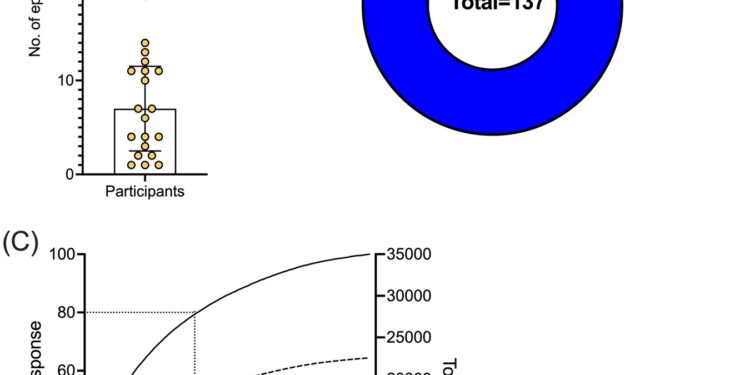Epitope magnitude and dominance in on-treatment ATB participants. A number of epitopes recognized by each participant. Each dot represents one participant, n = 21; the median ± interquartile range is shown. B Distribution of epitopes recognized according to the number of participants recognizing each epitope. C epitopes ranked according to magnitude of response (solid line – % of total response, dashed line – total number of spot-forming cells (SFC)). Black dashed lines indicate the first 55 epitopes. Credit: Natural communications (2024). DOI: 10.1038/s41467-024-45058-9
The La Jolla Immunology Institute (LJI) works to guide the development of new vaccines and drug therapies for tuberculosis. Now a team of LJI scientists has discovered important clues about how human T cells fight Mycobacterium tuberculosis, the bacteria that causes tuberculosis. Their findings were recently published in Natural communications.
“This research allows us to better understand T cell responses at different stages of TB infection and helps us determine whether there are additional diagnostic targets, vaccine targets or drug candidates to help people with the disease “, explains Cecilia, research assistant professor at LJI. Lindestam Arlehamn, Ph.D., who led the new research in collaboration with LJI professors Bjoern Peters, Ph.D., and Alessandro Sette, Dr.Biol.Sci.
The urgent need for tuberculosis research
According to the World Health Organization, more than 1.3 million people died from tuberculosis in 2022, making it the second leading infectious cause of death after COVID-19. “Tuberculosis is a huge problem in many countries,” says Lindestam Arlehamn.
Currently, a vaccine called Bacille Calmette-Guérin (BCG) protects against some serious cases of tuberculosis. Unfortunately, BCG does not consistently prevent cases of pulmonary tuberculosis, which can also be fatal. Although there are drug treatments for tuberculosis, more and more cases around the world are found to be resistant to the drugs.
To help stop tuberculosis, Lindestam Arlehamn and his colleagues are learning from T cells. T cells are essential for stopping infections from spreading throughout the body. Instead of targeting an entire pathogen, T cells look for specific markers, called peptide sequences, that belong to the pathogen. When a T cell recognizes a certain part of a pathogen’s peptide sequence, scientists call that area an “epitope.”
The discovery of T cell epitopes provides scientists with vital information about how vaccines and drug treatments could target the same epitopes to stop a pathogen.
Hierarchy of T cell reactivity against tuberculosis vaccine and IGRA antigens. Response magnitude, expressed as the total response magnitude (black bars, left Y axis) or the frequency of participant responses (gray bars, right Y axis), across participants. A ATB, not = 21. B IGRA+ in good health, not = 63, for comparison purposes. The Rv numbers of each antigen are shown on the x-axis. Credit: Natural communications(2024). DOI: 10.1038/s41467-024-45058-9
T cells target a range of TB epitopes
For the new study, the researchers worked with samples from patients undergoing treatment for active tuberculosis. These samples came from study participants in Peru, Sri Lanka and Moldova. By examining T cells in patients from three different continents, the researchers hoped to capture a wide diversity of genetic and environmental factors that can affect immune system activity.
In their analysis, the LJI team discovered 137 unique T cell epitopes. They found that 16 percent of these epitopes were targeted by T cells found in two or more patients. The immune system seemed to be working hard to zoom in on these epitopes.
In the future, the Lindestam Arlehamn laboratory will study which of these epitopes could be promising targets for future vaccines and drug therapies against tuberculosis.
A step towards better diagnosis
The new study is also a step toward detecting tuberculosis cases before they become fatal.
Since Mycobacterium tuberculosis is an airborne bacteria, a person can be exposed to it without ever realizing it. Once exposed, many people go months or years without any symptoms. This inactive, or “latent,” TB can develop into active TB if a person’s immune system weakens, for example during pregnancy or due to an infection such as HIV.
For the new study, the researchers also compared samples from patients with active tuberculosis to healthy individuals. The scientists discovered key differences in T cell responsiveness between the two groups. “For the first time, we were able to distinguish people with active tuberculosis from those who were exposed to tuberculosis or from unexposed individuals,” says Lindestam Arlehamn.
Lindestam Arlehamn says it may be possible to develop diagnostics to detect this telltale T-cell reactivity that marks a person’s transition from latent to active TB. “Can we use this pool of peptides to look for high-risk individuals and try to track them over time?” she asks.
More information:
Sudhasini Panda et al, Identification of differentially recognized T cell epitopes in the spectrum of tuberculosis infection, Natural communications(2024). DOI: 10.1038/s41467-024-45058-9
Provided by La Jolla Institute for Immunology
Quote: Examining how T cells fight tuberculosis (February 6, 2024) retrieved February 6, 2024 from
This document is subject to copyright. Apart from fair use for private study or research purposes, no part may be reproduced without written permission. The content is provided for information only.



